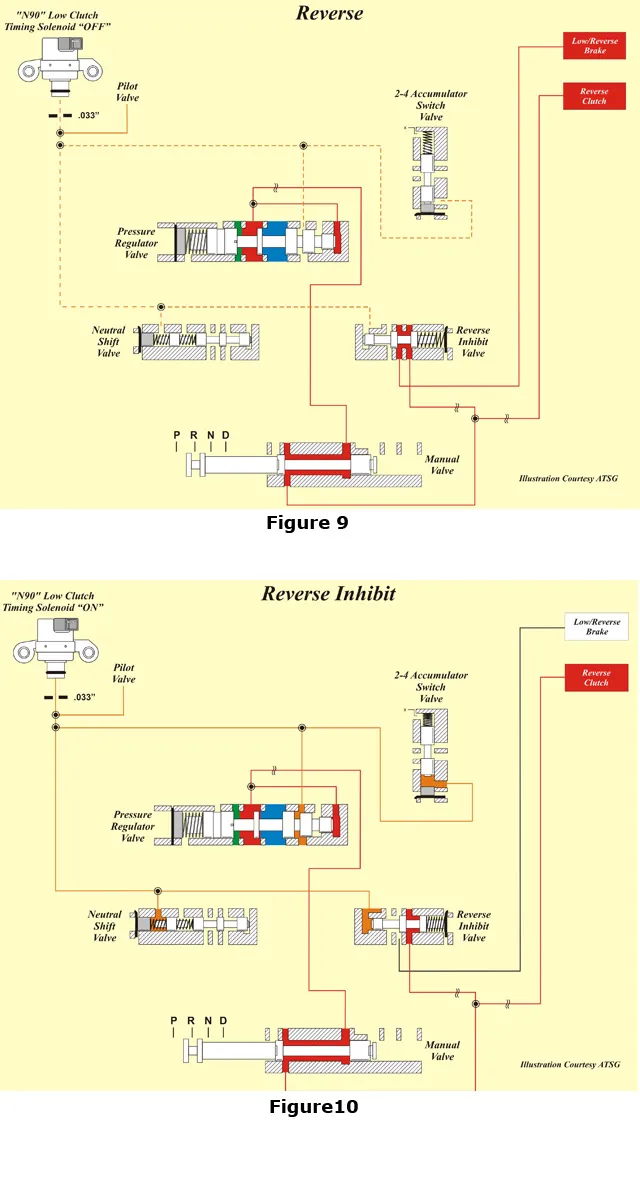With the quantity and price of solenoids becoming a substantial additional investment in the price of a transmission reman, testing and reclaiming the solenoids has become mandatory.
Every once in a while you run across a scenario that has you scratching your head. This was one of those units.
Our warranty dept. received a call from one of our retail locations. They had a 2002 Volkswagen Jetta with the O9A transaxle. The unit had been out approximately 300 miles and came back because of a no reverse complaint. All the external checks that could potentially inhibit reverse were investigated, everything was working properly. It was determined the unit would have to come out for further evaluation.
We received the unit back at the plant, and ran the unit on the dyno. Sure enough, when reverse was selected you could feel a partial engagement then a neutral. The drive engagement was fine. After air checking the unit I started with the valve body, taking it apart. Everything looked good, all the valves were free, the casting surfaces, separator plate and gaskets all looked good. No problem found.
I had all the solenoids retested and they checked out fine.
Ok, it's time to go into the unit, checking all components on the way out. Nothing was stripped or broken and the unit was assembled correctly. The unit was reassembled and it was run on the dyno, still no reverse engagement and no low/reverse clutch pressure. Something is inhibiting reverse, somehow, somewhere.
Forget about looking at an oil schematic, Volkswagen does not publish them. We pulled the unit off of the dyno removed and retested all the solenoids again, they retested good. I replaced the full set of solenoids, as a starting point and put the unit back on the dyno. The unit had a good reverse now. The issue was resolved, now its time to figure out why.

With all the solenoids in hand, it was off to the solenoid dept. All the solenoids were retested and all passed again. We lowered our control pressure on the solenoid dyno from our standard 80psi to 50psi and all passed except one solenoid, the low clutch timing solenoid stuck on.
We increased the control pressure to 75psi and it would work properly. Now its time to duplicate the actual operating pressure of the solenoid in the vehicle. To do this we had to do some creative engineering. Our machine shop fabricated a "test" solenoid with a pressure port. Figure 2.We installed the test solenoid in the unit. Figure 3. The pan was then installed. Figure 4.Then the vehicle was started and the actual solenoid operating pressure was approximately 66psi. Figure 5. It was amazing that only a 9psi difference of control pressure would influence whether the solenoid worked properly or failed (stuck). Now that we determined when the solenoid would fail we had to find out what was going on inside the solenoid.

The solenoid was disassembled and inspected (Figure 6) there was nothing obvious with the pintle or solenoid body, after studying the pieces to see how the solenoid operated mechanically I noticed the small plastic snout of the pintle would seal in the corresponding pocket in the plastic snout of the solenoid to shut the flow of oil off. What was happening was the tip of the pintle would wear enough (not much) and was sticking in the sealing pocket of the solenoid snout. Figures 7 and 8.

Now we know when and how the solenoid was failing. It's time to see why the unit had no reverse because of the issue. This is a normally "off" solenoid, so oil is flowing through the solenoid and exhausting out the back. Figure 9 shows the circuit working properly. Now enter the solenoid with the sticking pintle. With the solenoid mechanically stuck "on", the circuit became live. This caused the reverse inhibit valve to stroke. With this valve is in the stroked position the feed oil to the Low/Reverse Brake is cut off causing a "no reverse" or inhibited reverse. Figure 10.

I was amazed at how little a difference on operating pressure made such a huge difference on the solenoid operation. After working with the other solenoids in this unit we are finding the 09A solenoids are prone to be the "sticky solenoid" and we are very picky about reclaiming these solenoids. I want to give a "Thank You" to Jim Dial for providing the schematics on the reverse circuit for this unit. It makes understanding what is going on that much easier.
 Certified Transmission
Certified Transmission
